Balcony vegetable garden.
Are you ready to turn your balcony into a thriving oasis of fresh produce? With the right tools and techniques, you can create a successful vegetable garden right outside your door. Whether you have a small balcony or a spacious terrace, this article will guide you through the essential tools you need to maximize your balcony gardening experience. From selecting the right pots and containers to maintaining healthy plants and preventing pests, I will explore everything you need to know to create a bountiful balcony vegetable garden. Get ready to enjoy the satisfaction of growing your own food and transform your outdoor space into a green paradise.
This is a pinnable post. Tap or hover over any image in this post to pin to your Pinterest Boards.
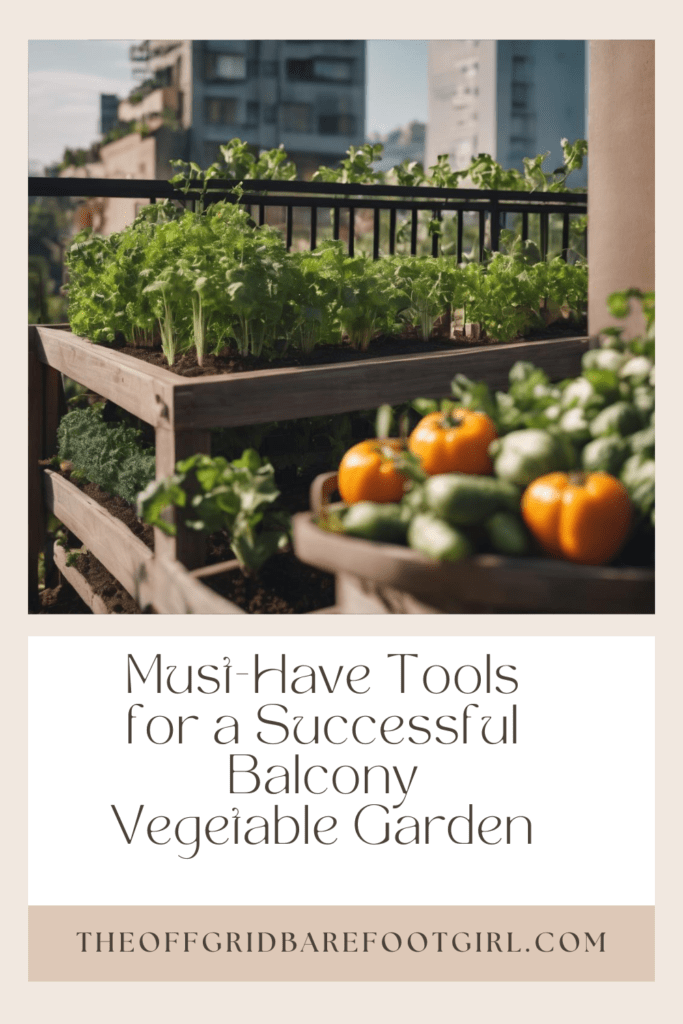
Introduction: The Benefits of a Balcony Vegetable Garden
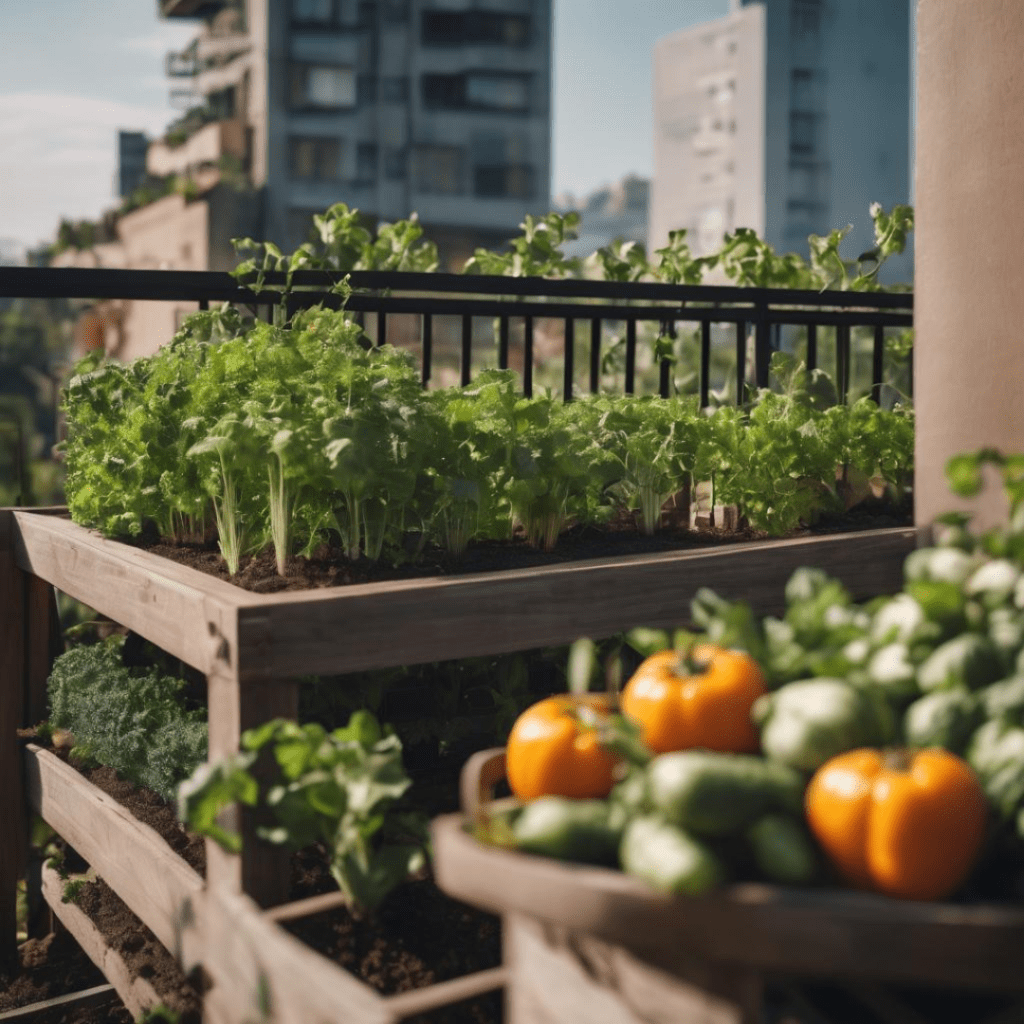
Picture this: stepping out onto your balcony, sipping your morning coffee, and being greeted by a garden full of fresh, homegrown vegetables, making you forget about being in the city. Sounds dreamy, doesn’t it? Well, it can be your reality with a balcony vegetable garden!
Not all of us have access to vast stretches of land or the ability move to the country, but that doesn’t mean we can’t indulge in the joy of growing our own food. A balcony vegetable garden allows you to make the most of a limited space and bring the beauty and rewards of gardening right to your doorstep!
Not only does a balcony garden provide you with a source of fresh, organic produce, but it also offers a therapeutic escape from the hustle and bustle of daily life, especially in the city! Plus, it’s a great conversation starter when your guests marvel at your green thumb skills.
In this article, I’ll explore the essential tools you’ll need to create a successful balcony vegetable garden. So, grab your trowel, and let’s get gardening!
Essential Tools for Balcony Gardening
Basic Hand Tools
Every gardener needs a trusty set of hand tools. Here’s a rundown of the basics you’ll want to have in your gardening arsenal:
- A Sturdy Trowel: Perfect for digging holes, transplanting seedlings, and scooping soil. Treat it like your best friend in the garden.
- A Hand Fork: Ideal for loosening soil, breaking up clumps, and weeding. It’s like a tiny pitchfork, but without the terrifying image of angry villagers chasing you.
- Pruners: For trimming and shaping your plants. Just make sure not to go overboard and accidentally give your tomato plant a new haircut.
Specialty Tools for Small Spaces
Balcony gardening often calls for some specialized tools to make the most of your limited space. Here are a few nifty gadgets to consider adding to your collection:
- Vertical Gardening Systems: These contraptions allow you to grow plants vertically, saving precious floor space. It’s like a veggie high-rise for your balcony. Grow towers are perfect vertical gardens, holding 30-50 plants in a small space in a beautiful way. These can be placed in the sunny corners of balconies!
- Self-Watering Containers: Perfect for those times when life gets busy, and you forget to water your plants. The containers come with a built-in reservoir that keeps your plants hydrated, even when you’re not around.
- Hanging Planters: When the floor space is limited, hanging planters come to the rescue. They dangle from railings or hooks, adding a touch of whimsy to your balcony garden.
Selecting the Right Pots and Containers
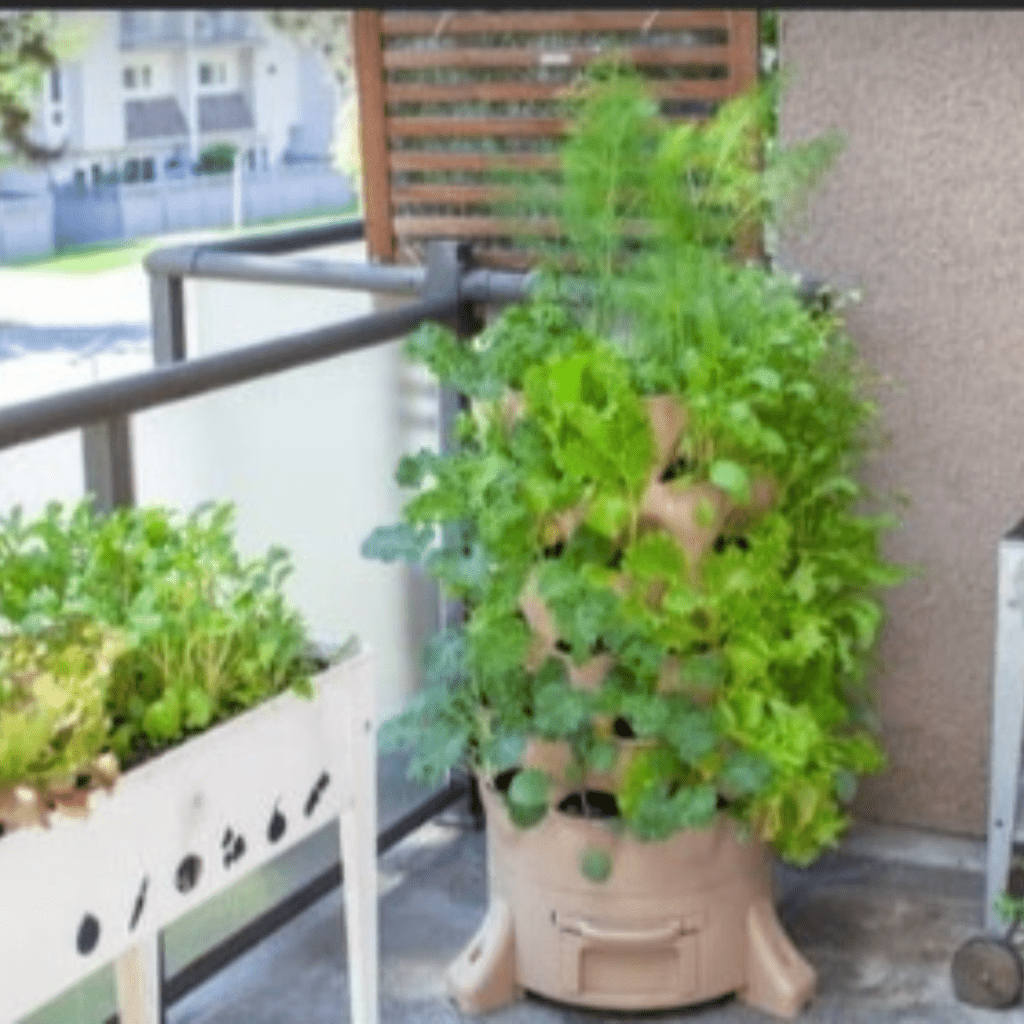
Considerations for Container Selection
Choosing the right pots and containers is crucial for a successful balcony garden. Here are a few key things to consider:
- Size Matters: Ensure your containers are deep enough for the roots to grow and have sufficient drainage holes to prevent waterlogging. Just like us, plants need room to stretch their legs and good drainage to avoid soggy feet.
- Material Choice: Select containers made from materials that won’t heat up too much under the scorching sun or freeze your plants’ roots in winter.
Types of Containers for Balcony Gardens
The world of container options is vast, so here are a few popular choices for balcony gardens:
- Traditional Clay Pots: Classic, elegant, and great for breathability. Just be cautious as they can become heavy when filled with soil, so be prepared to flex those muscles.
- Fabric Grow Bags: Lightweight and easy to move around. Plus, they offer excellent drainage and are an eco-friendly alternative to plastic pots.
- Hanging Baskets: Perfect for trailing plants like cherry tomatoes or vibrant flowers like petunias. They add a touch of whimsy and color to your balcony garden.
Soil and Fertilizer: Ensuring Nutrient-Rich Growing Medium
Understanding Soil Requirements
Healthy soil is the backbone of a successful garden, so it’s crucial to understand its needs. Here are a few pointers:
- Well-Draining Soil: Most vegetable plants prefer soil that drains well to prevent root rot. So, choose a high-quality potting mix with good drainage characteristics.
- Nutrient-Rich Soil: Vegetables are voracious eaters, so they’ll need nutrient-rich soil to thrive. Consider amending your potting mix with compost or organic fertilizers to provide a buffet of nutrients for your hungry plants.
Choosing the Right Fertilizers
When it comes to fertilizers, it’s like choosing the perfect meal plan for your plants. Here are a few options to consider:
- Organic Fertilizers: These are derived from natural sources and release nutrients slowly over time, giving your plants a steady supply of nourishment. They’re like the gourmet treats of the plant world.
- Slow-Release Fertilizers: These little pellets or sticks release nutrients gradually, saving you from the hassle of frequent feeding. It’s like the slow cooker of fertilizers, making sure your plants are well-fed without constant attention.
With the right tools, pots, and soil, your balcony vegetable garden will become a flourishing oasis of fresh produce. So, go forth and conquer that small space with your green thumb and a touch of balcony gardening magic.
Irrigation and Watering: Efficient Techniques for Balcony Gardens
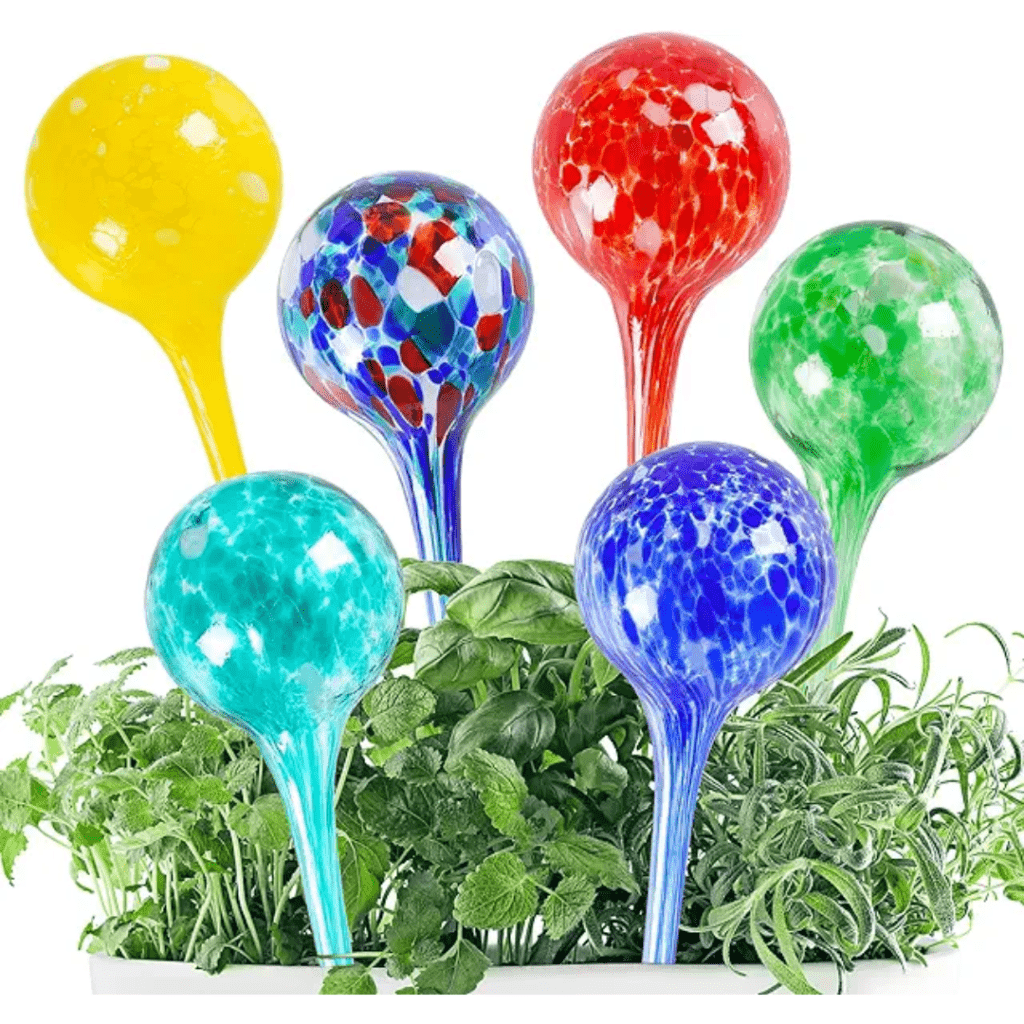
When it comes to balcony gardening, watering is a crucial aspect. After all, plants need water like we need our morning coffee. Finding the right watering techniques can make all the difference in the success of your balcony vegetable garden.
Watering Methods and Frequency
You may be tempted to give your plants a waterfall-inspired shower every day, but resist the urge! Overwatering can drown your poor plants and make them feel like they’re stuck in a never-ending rainstorm. Instead, aim for a good soak two to three times a week, depending on the weather and specific needs of your plants. Remember, it’s better to underwater a bit than to drown them in water.
When it comes to watering methods, a gentle and steady approach often works wonders. Use a watering can with a long spout to reach those hard-to-reach areas and water directly at the base of the plants. Avoid blasting them with a power hose, unless you want your balcony to resemble a mini waterpark.
Self-Watering Systems
If you’re a busy bee or just have a habit of forgetting to water your plants, self-watering systems can be a game-changer. These nifty contraptions ensure a constant supply of water to your plants, so they can happily thrive even when you’re not around. From simple wick-based systems to sophisticated drip irrigation setups, there’s a self-watering system out there to suit your needs.
Pruning and Maintenance: Keeping Your Plants Healthy and Productive
Just like we need haircuts to keep our locks in check, plants need pruning to stay healthy and productive. Don’t worry, you won’t need a degree in horticulture to master this skill.
Importance of Pruning in Balcony Gardening
Pruning involves removing dead or damaged leaves, stems, or branches from your plants. Not only does this keep them looking tidy and Instagram-ready, but it also promotes new growth and prevents diseases from spreading.
Tips for Proper Plant Maintenance
In addition to regular pruning, maintaining your plants involves a few other tasks. Keep an eye out for weeds and nip them in the bud (literally) before they take over your precious balcony oasis. Regularly check your plants for signs of pests or diseases, and take appropriate action if you spot any unwanted visitors. And don’t forget to give your plants some love by periodically feeding them with a balanced fertilizer. Remember, happy plants lead to a happy you!
Pest Control and Disease Prevention: Protecting Your Balcony Garden
No one wants uninvited guests at their garden party, especially when those guests come in the form of pesky insects or diseases that threaten your lush green haven.
Common Pests and Diseases in Balcony Gardens
Aphids, spider mites, and powdery mildew are just a few of the unwanted intruders that can wreak havoc on your balcony garden. These little troublemakers can quickly multiply and turn your thriving plants into a mess. However, there are ways you can combat these issues.
Natural and Organic Pest Control Methods
Before you unleash chemical warfare, consider trying natural and organic pest control methods. Introduce insect-repelling plants like marigolds or lavender to your garden, or whip up a homemade pest spray using ingredients like neem oil or garlic. You’ll be the “peaceful warrior” of pest control in no time! Here are some helpful posts I have written to help you naturally combat pests and diseases in your garden and avoid unleashing chemical warfare on your precious plants.
- How to Effectively Combat Powdery Mildew in Your Garden
- The Best Garden Snail Control Strategies
- The Best Tips for Organic Gardening
- How to Do Companion Planting: Friends or Foes?
Harvesting and Enjoying the Fruits of Your Labor
Finally, the moment you’ve been eagerly waiting for: it’s harvest time! Now, it’s time to reap the rewards of your hard work and enjoy the delicious fruits (or veggies) of your labor!
Knowing When and How to Harvest
Each plant has its own unique harvesting time, so keep an eye out for signs that they’re ready to be picked. Whether it’s a juicy tomato, a vibrant bell pepper, or a crunchy cucumber, know when it’s ripe and pluck it with pride. But be gentle, no plant wants to be yanked out like a stubborn weed!
Creative Ways to Use and Enjoy Your Homegrown Produce
Now that you’ve gathered your garden’s treasures, it’s time to get creative in the kitchen. Whip up a fresh salad bursting with flavors, blend up a refreshing smoothie, or try your hand at homemade salsa. Don’t be afraid to experiment and let your homegrown produce shine in all its glory. After all, it’s the taste of victory!
Conclusion
By utilizing these must-have tools for your balcony vegetable garden, you are well on your way to enjoying the joys of homegrown produce and the beauty of a lush green space right on your balcony. Remember to choose the right pots and containers, nourish your plants with nutrient-rich soil and fertilizer, water them efficiently, and maintain their health through pruning and pest control. With dedication and care, your balcony garden will reward you with a harvest of fresh vegetables and a tranquil sanctuary to relax in. Embrace the journey of balcony gardening and savor the delicious rewards it brings!
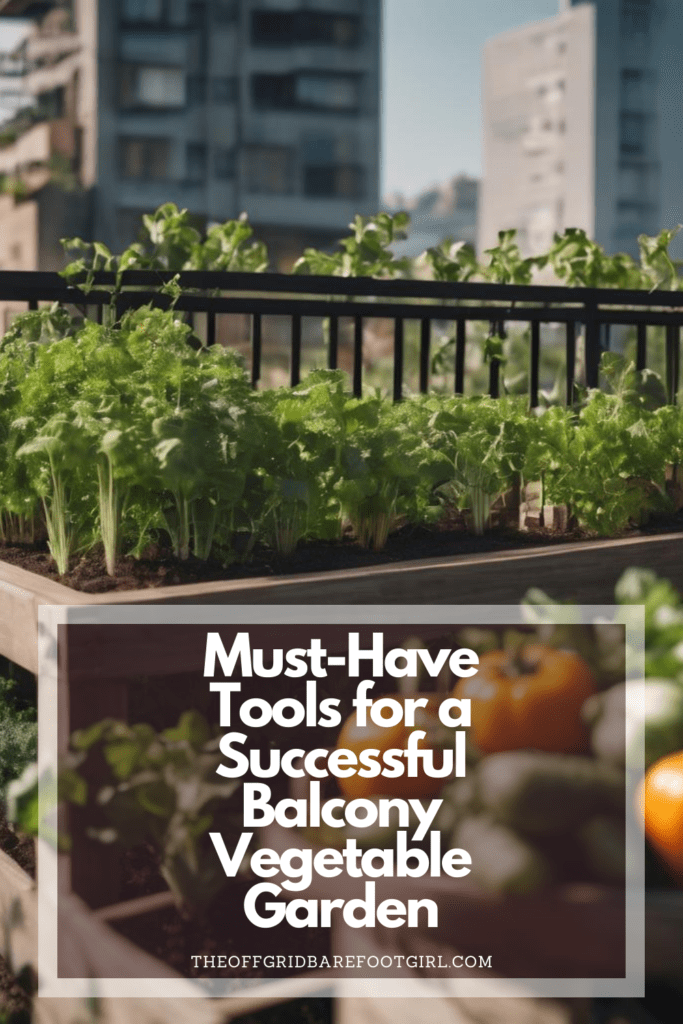
Frequently Asked Questions
1. Can I start a vegetable garden on a small balcony?
Absolutely! Even a small balcony can be transformed into a productive vegetable garden. You can use hanging baskets, vertical planters, or compact containers to maximize your space. Just ensure your chosen plants receive adequate sunlight and proper care.
2. How often should I water my balcony garden?
The frequency of watering will vary depending on factors such as the type of plants, weather conditions, and container materials. As a general guideline, check the moisture level of the soil regularly and water when the top inch feels dry. Avoid overwatering as it can lead to root rot.
3. What are some natural methods to control pests in a balcony garden?
There are several natural methods to control pests in your balcony garden. You can introduce beneficial insects like ladybugs or lacewings, use neem oil or insecticidal soap, and practice companion planting to deter pests. Additionally, regularly inspecting your plants for signs of infestation can help you catch and address any issues early.
4. Can I grow vegetables without direct sunlight on my balcony?
While most vegetables thrive with direct sunlight, there are some that can tolerate partial shade or indirect sunlight. Leafy greens like spinach and lettuce, as well as herbs like mint and parsley, can grow in areas with limited sunlight. However, it’s important to ensure they still receive a few hours of sunlight each day for optimal growth.
Summary
I hope I have inspired you to grow a balcony vegetable garden with these tips and products.
If you were encouraged by this post, I invite you to check out my FREE Printables Page for fun free printables, planners, and charts.
ENTER MY FREE Printables Page HERE
Here are some more of my gardening inspiration posts to check out!
How to Effectively Combat Powdery Mildew in Your Garden
The Best Tips for Organic Gardening
How to Release Ladybugs In Your Garden for Organic Pest Control
The Best Garden Snail Control Strategies
The Best Spring Vegetables to Grow in Your Garden
Seed Starter Mix: How To Make Your Organic Seed Starter Mix At Home
How to Grow a Productive Canning Garden
How to Plant and Grow a Salsa Garden
Easiest Heirloom Vegetable Seeds to Grow Now
How to Use the Hand Twist Claw Tiller: Tackling Tough Soil
Planning Your Garden: How to Plan a Vegetable Garden: Expert Green Thumb Tips!
Winterizing the Garden: How to Winterize Your Vegetable Garden: Step-by-Step Checklist
Mulching the Garden: How to Make Leaf Litter Mulch
Grow a Pumpkin Patch: How to Grow a Pumpkin Patch in Your Backyard
How to Win a Giant Pumpkin Contest
How to Grow a Fall Garden: 9 Best Fall Crops
Clever Ways to Incorporate Indoor Composting into Your Home
How to Start Composting for the Garden: A Step-by-Step Guide
The Ultimate Guide to Composting in Your Suburban Backyard
Why I Built A Survival Garden in My Backyard
How to Grow A Foodscape Garden From Scratch
16 Best Medicinal Herbs to Grow in Your Garden Now
Blessings,
The Off Grid Barefoot Girl




